SNHU Project: Network Infrastructure, Security & Management Plan
VerifiedAdded on 2023/06/10
|20
|3174
|100
Project
AI Summary
This project management document outlines a comprehensive plan for enhancing the network infrastructure at Southern New Hampshire University (SNHU). It details the project's scope, including the deployment of an open-source system and a computer vulnerability inspection program across the campus. The plan addresses project constraints, communication strategies, stakeholder analysis, and risk management. Key components include a work breakdown structure, time and cost estimations, and quality estimations. The document also covers security measures, such as VLAN implementation, firewall deployment, and VPN usage for branch campuses. The project emphasizes improving customer service through clear self-remediation instructions and administrative quarantine for security complaints. The report concludes with a project sign-off letter, a project review, and recommendations for future improvements, focusing on scalability, security, and cost-effectiveness. Desklib offers this document and many others to aid students in their studies.
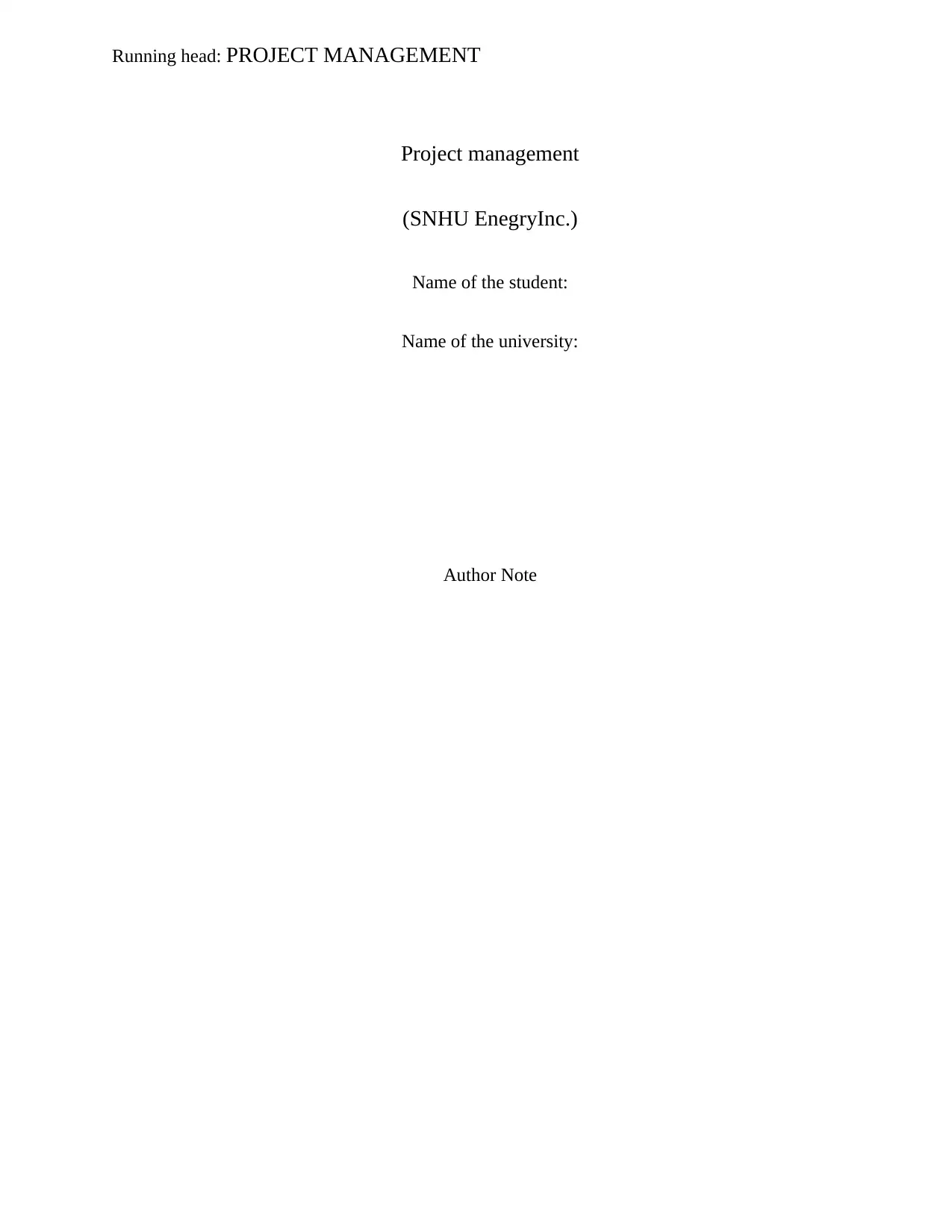
Running head: PROJECT MANAGEMENT
Project management
(SNHU EnegryInc.)
Name of the student:
Name of the university:
Author Note
Project management
(SNHU EnegryInc.)
Name of the student:
Name of the university:
Author Note
Paraphrase This Document
Need a fresh take? Get an instant paraphrase of this document with our AI Paraphraser
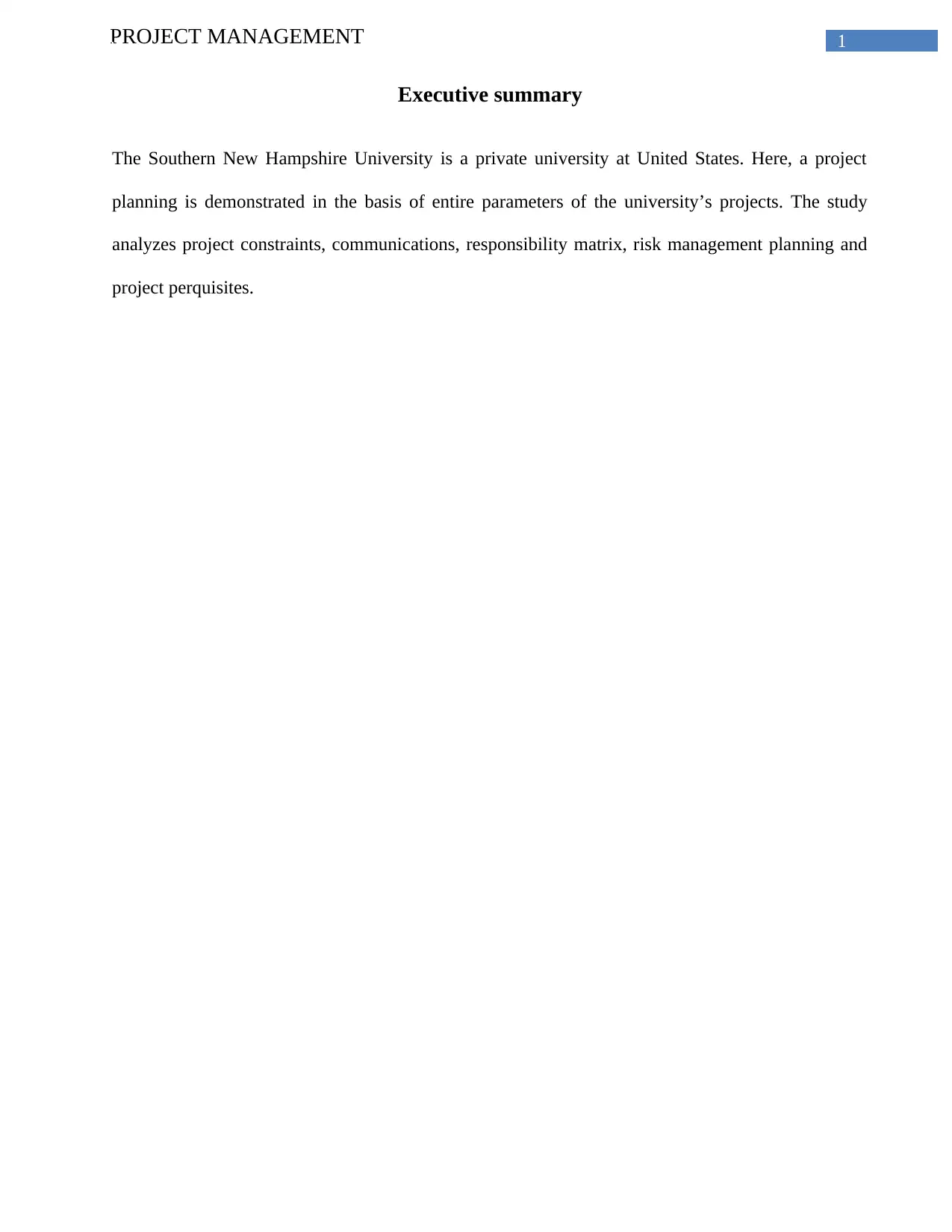
1PROJECT MANAGEMENT
Executive summary
The Southern New Hampshire University is a private university at United States. Here, a project
planning is demonstrated in the basis of entire parameters of the university’s projects. The study
analyzes project constraints, communications, responsibility matrix, risk management planning and
project perquisites.
Executive summary
The Southern New Hampshire University is a private university at United States. Here, a project
planning is demonstrated in the basis of entire parameters of the university’s projects. The study
analyzes project constraints, communications, responsibility matrix, risk management planning and
project perquisites.
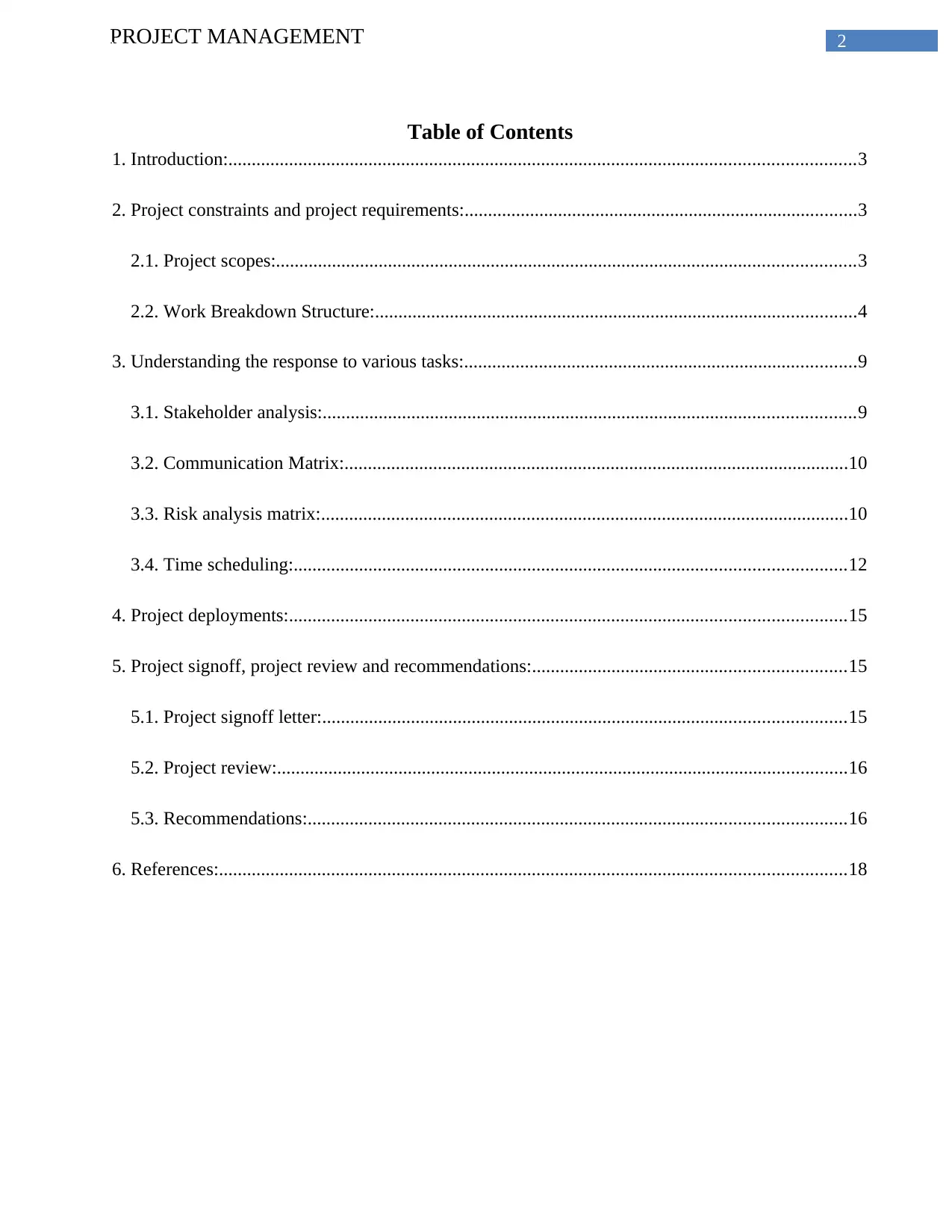
2PROJECT MANAGEMENT
Table of Contents
1. Introduction:......................................................................................................................................3
2. Project constraints and project requirements:....................................................................................3
2.1. Project scopes:............................................................................................................................3
2.2. Work Breakdown Structure:.......................................................................................................4
3. Understanding the response to various tasks:....................................................................................9
3.1. Stakeholder analysis:..................................................................................................................9
3.2. Communication Matrix:............................................................................................................10
3.3. Risk analysis matrix:.................................................................................................................10
3.4. Time scheduling:......................................................................................................................12
4. Project deployments:.......................................................................................................................15
5. Project signoff, project review and recommendations:...................................................................15
5.1. Project signoff letter:................................................................................................................15
5.2. Project review:..........................................................................................................................16
5.3. Recommendations:...................................................................................................................16
6. References:......................................................................................................................................18
Table of Contents
1. Introduction:......................................................................................................................................3
2. Project constraints and project requirements:....................................................................................3
2.1. Project scopes:............................................................................................................................3
2.2. Work Breakdown Structure:.......................................................................................................4
3. Understanding the response to various tasks:....................................................................................9
3.1. Stakeholder analysis:..................................................................................................................9
3.2. Communication Matrix:............................................................................................................10
3.3. Risk analysis matrix:.................................................................................................................10
3.4. Time scheduling:......................................................................................................................12
4. Project deployments:.......................................................................................................................15
5. Project signoff, project review and recommendations:...................................................................15
5.1. Project signoff letter:................................................................................................................15
5.2. Project review:..........................................................................................................................16
5.3. Recommendations:...................................................................................................................16
6. References:......................................................................................................................................18
⊘ This is a preview!⊘
Do you want full access?
Subscribe today to unlock all pages.

Trusted by 1+ million students worldwide
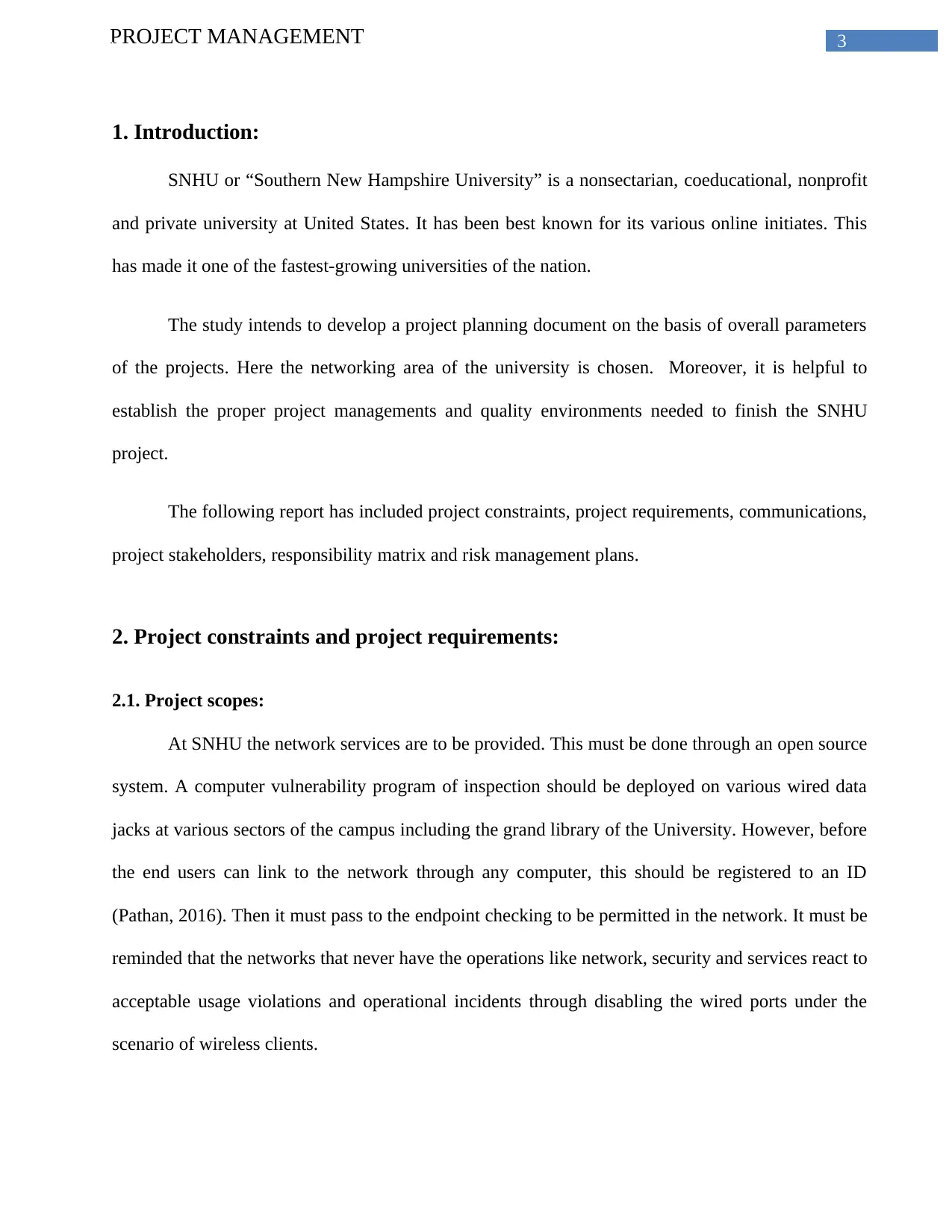
3PROJECT MANAGEMENT
1. Introduction:
SNHU or “Southern New Hampshire University” is a nonsectarian, coeducational, nonprofit
and private university at United States. It has been best known for its various online initiates. This
has made it one of the fastest-growing universities of the nation.
The study intends to develop a project planning document on the basis of overall parameters
of the projects. Here the networking area of the university is chosen. Moreover, it is helpful to
establish the proper project managements and quality environments needed to finish the SNHU
project.
The following report has included project constraints, project requirements, communications,
project stakeholders, responsibility matrix and risk management plans.
2. Project constraints and project requirements:
2.1. Project scopes:
At SNHU the network services are to be provided. This must be done through an open source
system. A computer vulnerability program of inspection should be deployed on various wired data
jacks at various sectors of the campus including the grand library of the University. However, before
the end users can link to the network through any computer, this should be registered to an ID
(Pathan, 2016). Then it must pass to the endpoint checking to be permitted in the network. It must be
reminded that the networks that never have the operations like network, security and services react to
acceptable usage violations and operational incidents through disabling the wired ports under the
scenario of wireless clients.
1. Introduction:
SNHU or “Southern New Hampshire University” is a nonsectarian, coeducational, nonprofit
and private university at United States. It has been best known for its various online initiates. This
has made it one of the fastest-growing universities of the nation.
The study intends to develop a project planning document on the basis of overall parameters
of the projects. Here the networking area of the university is chosen. Moreover, it is helpful to
establish the proper project managements and quality environments needed to finish the SNHU
project.
The following report has included project constraints, project requirements, communications,
project stakeholders, responsibility matrix and risk management plans.
2. Project constraints and project requirements:
2.1. Project scopes:
At SNHU the network services are to be provided. This must be done through an open source
system. A computer vulnerability program of inspection should be deployed on various wired data
jacks at various sectors of the campus including the grand library of the University. However, before
the end users can link to the network through any computer, this should be registered to an ID
(Pathan, 2016). Then it must pass to the endpoint checking to be permitted in the network. It must be
reminded that the networks that never have the operations like network, security and services react to
acceptable usage violations and operational incidents through disabling the wired ports under the
scenario of wireless clients.
Paraphrase This Document
Need a fresh take? Get an instant paraphrase of this document with our AI Paraphraser
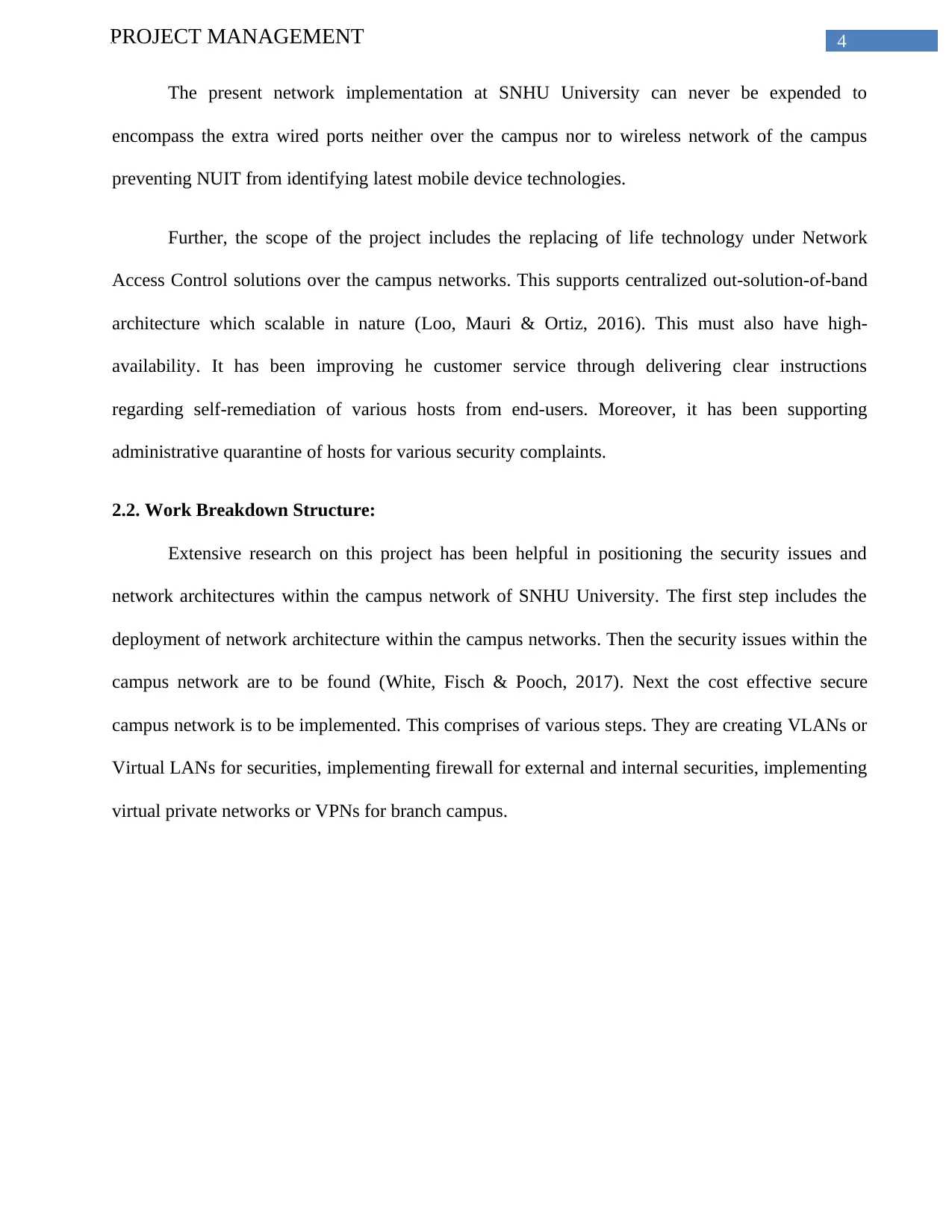
4PROJECT MANAGEMENT
The present network implementation at SNHU University can never be expended to
encompass the extra wired ports neither over the campus nor to wireless network of the campus
preventing NUIT from identifying latest mobile device technologies.
Further, the scope of the project includes the replacing of life technology under Network
Access Control solutions over the campus networks. This supports centralized out-solution-of-band
architecture which scalable in nature (Loo, Mauri & Ortiz, 2016). This must also have high-
availability. It has been improving he customer service through delivering clear instructions
regarding self-remediation of various hosts from end-users. Moreover, it has been supporting
administrative quarantine of hosts for various security complaints.
2.2. Work Breakdown Structure:
Extensive research on this project has been helpful in positioning the security issues and
network architectures within the campus network of SNHU University. The first step includes the
deployment of network architecture within the campus networks. Then the security issues within the
campus network are to be found (White, Fisch & Pooch, 2017). Next the cost effective secure
campus network is to be implemented. This comprises of various steps. They are creating VLANs or
Virtual LANs for securities, implementing firewall for external and internal securities, implementing
virtual private networks or VPNs for branch campus.
The present network implementation at SNHU University can never be expended to
encompass the extra wired ports neither over the campus nor to wireless network of the campus
preventing NUIT from identifying latest mobile device technologies.
Further, the scope of the project includes the replacing of life technology under Network
Access Control solutions over the campus networks. This supports centralized out-solution-of-band
architecture which scalable in nature (Loo, Mauri & Ortiz, 2016). This must also have high-
availability. It has been improving he customer service through delivering clear instructions
regarding self-remediation of various hosts from end-users. Moreover, it has been supporting
administrative quarantine of hosts for various security complaints.
2.2. Work Breakdown Structure:
Extensive research on this project has been helpful in positioning the security issues and
network architectures within the campus network of SNHU University. The first step includes the
deployment of network architecture within the campus networks. Then the security issues within the
campus network are to be found (White, Fisch & Pooch, 2017). Next the cost effective secure
campus network is to be implemented. This comprises of various steps. They are creating VLANs or
Virtual LANs for securities, implementing firewall for external and internal securities, implementing
virtual private networks or VPNs for branch campus.
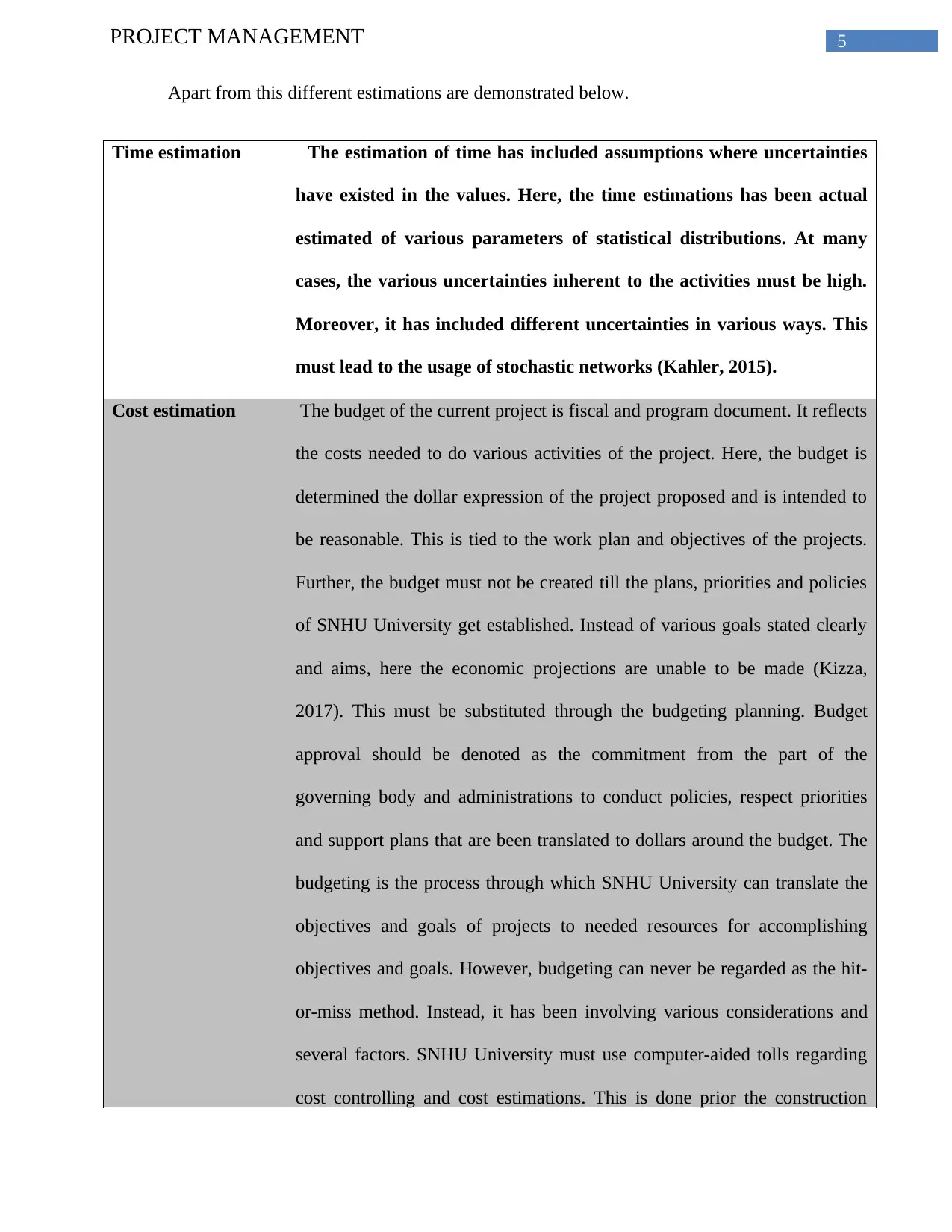
5PROJECT MANAGEMENT
Apart from this different estimations are demonstrated below.
Time estimation The estimation of time has included assumptions where uncertainties
have existed in the values. Here, the time estimations has been actual
estimated of various parameters of statistical distributions. At many
cases, the various uncertainties inherent to the activities must be high.
Moreover, it has included different uncertainties in various ways. This
must lead to the usage of stochastic networks (Kahler, 2015).
Cost estimation The budget of the current project is fiscal and program document. It reflects
the costs needed to do various activities of the project. Here, the budget is
determined the dollar expression of the project proposed and is intended to
be reasonable. This is tied to the work plan and objectives of the projects.
Further, the budget must not be created till the plans, priorities and policies
of SNHU University get established. Instead of various goals stated clearly
and aims, here the economic projections are unable to be made (Kizza,
2017). This must be substituted through the budgeting planning. Budget
approval should be denoted as the commitment from the part of the
governing body and administrations to conduct policies, respect priorities
and support plans that are been translated to dollars around the budget. The
budgeting is the process through which SNHU University can translate the
objectives and goals of projects to needed resources for accomplishing
objectives and goals. However, budgeting can never be regarded as the hit-
or-miss method. Instead, it has been involving various considerations and
several factors. SNHU University must use computer-aided tolls regarding
cost controlling and cost estimations. This is done prior the construction
Apart from this different estimations are demonstrated below.
Time estimation The estimation of time has included assumptions where uncertainties
have existed in the values. Here, the time estimations has been actual
estimated of various parameters of statistical distributions. At many
cases, the various uncertainties inherent to the activities must be high.
Moreover, it has included different uncertainties in various ways. This
must lead to the usage of stochastic networks (Kahler, 2015).
Cost estimation The budget of the current project is fiscal and program document. It reflects
the costs needed to do various activities of the project. Here, the budget is
determined the dollar expression of the project proposed and is intended to
be reasonable. This is tied to the work plan and objectives of the projects.
Further, the budget must not be created till the plans, priorities and policies
of SNHU University get established. Instead of various goals stated clearly
and aims, here the economic projections are unable to be made (Kizza,
2017). This must be substituted through the budgeting planning. Budget
approval should be denoted as the commitment from the part of the
governing body and administrations to conduct policies, respect priorities
and support plans that are been translated to dollars around the budget. The
budgeting is the process through which SNHU University can translate the
objectives and goals of projects to needed resources for accomplishing
objectives and goals. However, budgeting can never be regarded as the hit-
or-miss method. Instead, it has been involving various considerations and
several factors. SNHU University must use computer-aided tolls regarding
cost controlling and cost estimations. This is done prior the construction
⊘ This is a preview!⊘
Do you want full access?
Subscribe today to unlock all pages.

Trusted by 1+ million students worldwide
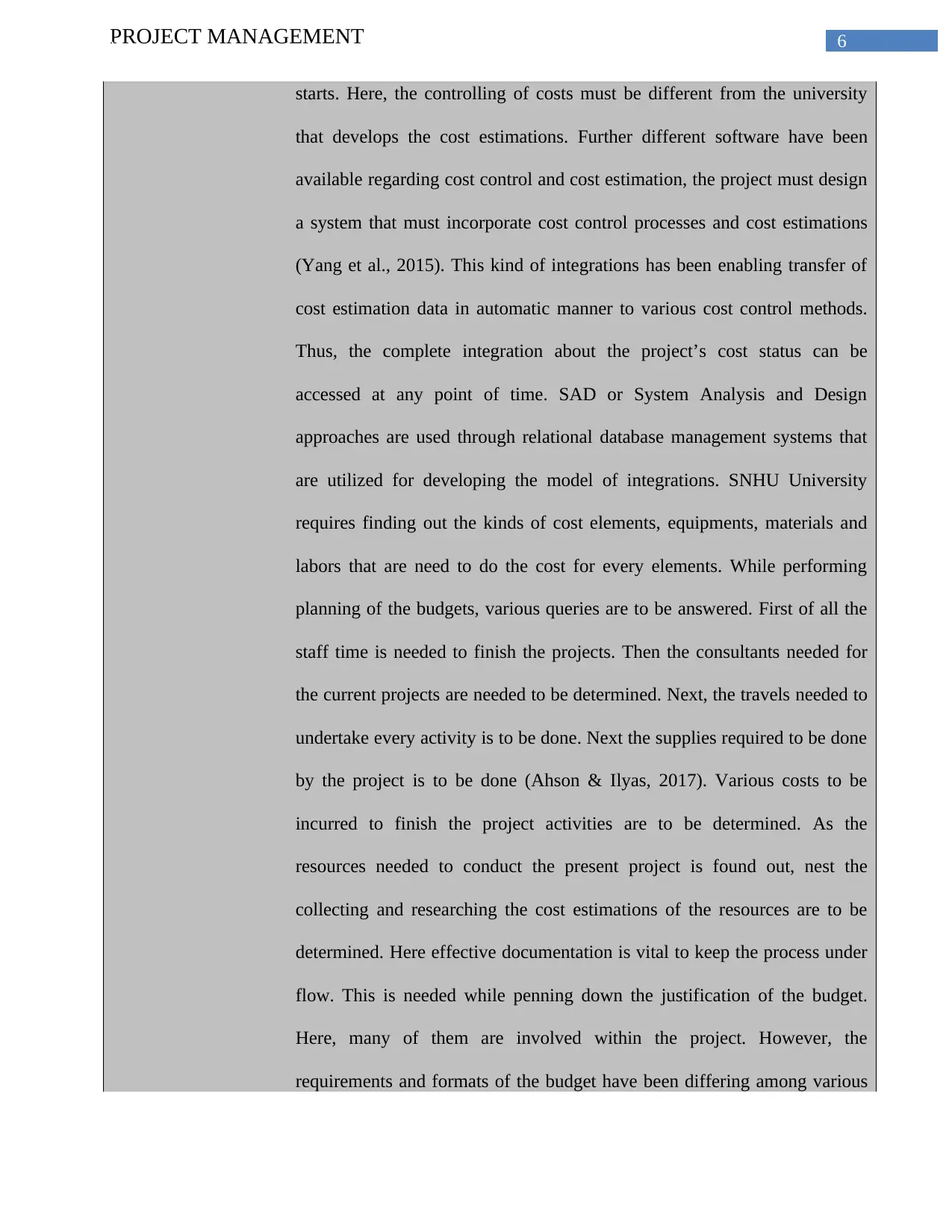
6PROJECT MANAGEMENT
starts. Here, the controlling of costs must be different from the university
that develops the cost estimations. Further different software have been
available regarding cost control and cost estimation, the project must design
a system that must incorporate cost control processes and cost estimations
(Yang et al., 2015). This kind of integrations has been enabling transfer of
cost estimation data in automatic manner to various cost control methods.
Thus, the complete integration about the project’s cost status can be
accessed at any point of time. SAD or System Analysis and Design
approaches are used through relational database management systems that
are utilized for developing the model of integrations. SNHU University
requires finding out the kinds of cost elements, equipments, materials and
labors that are need to do the cost for every elements. While performing
planning of the budgets, various queries are to be answered. First of all the
staff time is needed to finish the projects. Then the consultants needed for
the current projects are needed to be determined. Next, the travels needed to
undertake every activity is to be done. Next the supplies required to be done
by the project is to be done (Ahson & Ilyas, 2017). Various costs to be
incurred to finish the project activities are to be determined. As the
resources needed to conduct the present project is found out, nest the
collecting and researching the cost estimations of the resources are to be
determined. Here effective documentation is vital to keep the process under
flow. This is needed while penning down the justification of the budget.
Here, many of them are involved within the project. However, the
requirements and formats of the budget have been differing among various
starts. Here, the controlling of costs must be different from the university
that develops the cost estimations. Further different software have been
available regarding cost control and cost estimation, the project must design
a system that must incorporate cost control processes and cost estimations
(Yang et al., 2015). This kind of integrations has been enabling transfer of
cost estimation data in automatic manner to various cost control methods.
Thus, the complete integration about the project’s cost status can be
accessed at any point of time. SAD or System Analysis and Design
approaches are used through relational database management systems that
are utilized for developing the model of integrations. SNHU University
requires finding out the kinds of cost elements, equipments, materials and
labors that are need to do the cost for every elements. While performing
planning of the budgets, various queries are to be answered. First of all the
staff time is needed to finish the projects. Then the consultants needed for
the current projects are needed to be determined. Next, the travels needed to
undertake every activity is to be done. Next the supplies required to be done
by the project is to be done (Ahson & Ilyas, 2017). Various costs to be
incurred to finish the project activities are to be determined. As the
resources needed to conduct the present project is found out, nest the
collecting and researching the cost estimations of the resources are to be
determined. Here effective documentation is vital to keep the process under
flow. This is needed while penning down the justification of the budget.
Here, many of them are involved within the project. However, the
requirements and formats of the budget have been differing among various
Paraphrase This Document
Need a fresh take? Get an instant paraphrase of this document with our AI Paraphraser
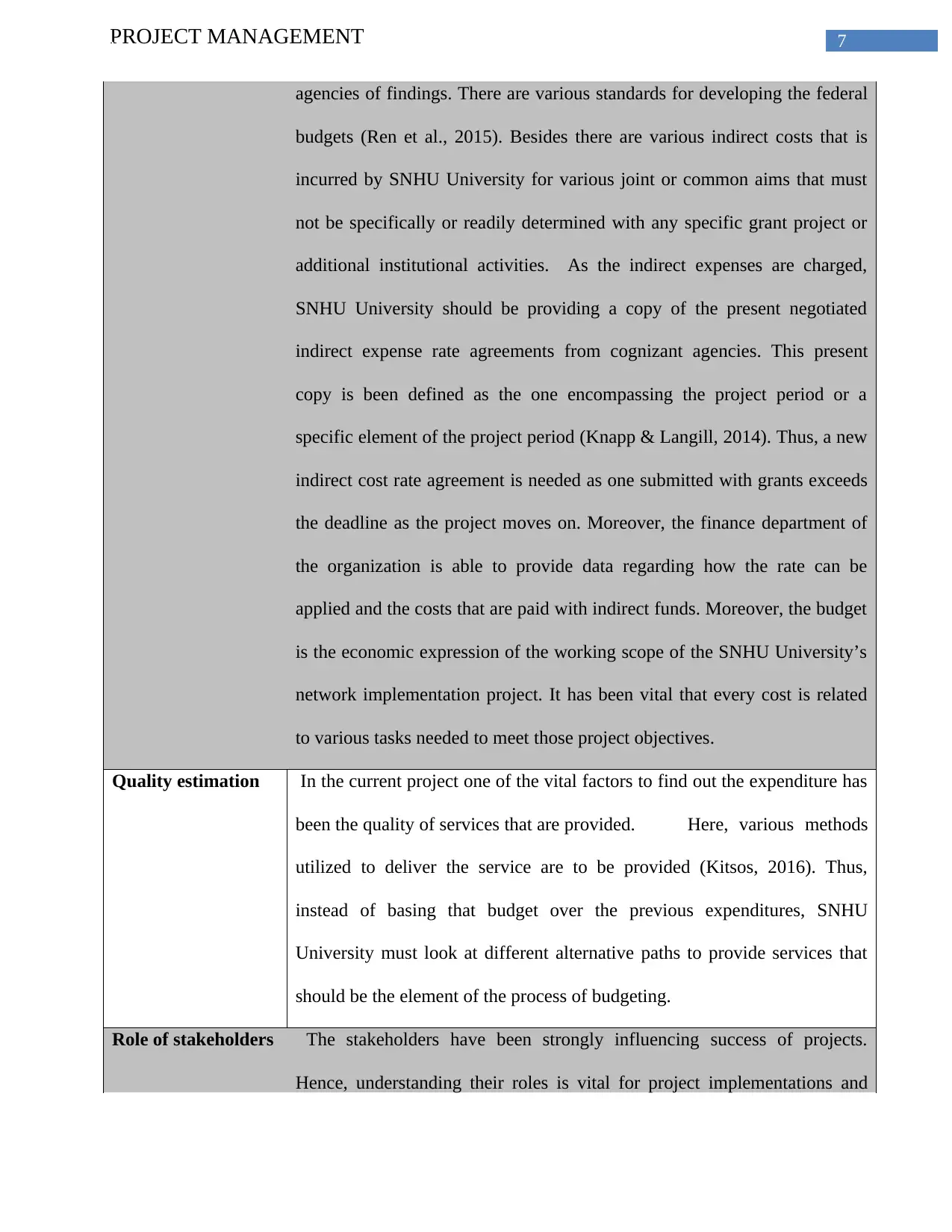
7PROJECT MANAGEMENT
agencies of findings. There are various standards for developing the federal
budgets (Ren et al., 2015). Besides there are various indirect costs that is
incurred by SNHU University for various joint or common aims that must
not be specifically or readily determined with any specific grant project or
additional institutional activities. As the indirect expenses are charged,
SNHU University should be providing a copy of the present negotiated
indirect expense rate agreements from cognizant agencies. This present
copy is been defined as the one encompassing the project period or a
specific element of the project period (Knapp & Langill, 2014). Thus, a new
indirect cost rate agreement is needed as one submitted with grants exceeds
the deadline as the project moves on. Moreover, the finance department of
the organization is able to provide data regarding how the rate can be
applied and the costs that are paid with indirect funds. Moreover, the budget
is the economic expression of the working scope of the SNHU University’s
network implementation project. It has been vital that every cost is related
to various tasks needed to meet those project objectives.
Quality estimation In the current project one of the vital factors to find out the expenditure has
been the quality of services that are provided. Here, various methods
utilized to deliver the service are to be provided (Kitsos, 2016). Thus,
instead of basing that budget over the previous expenditures, SNHU
University must look at different alternative paths to provide services that
should be the element of the process of budgeting.
Role of stakeholders The stakeholders have been strongly influencing success of projects.
Hence, understanding their roles is vital for project implementations and
agencies of findings. There are various standards for developing the federal
budgets (Ren et al., 2015). Besides there are various indirect costs that is
incurred by SNHU University for various joint or common aims that must
not be specifically or readily determined with any specific grant project or
additional institutional activities. As the indirect expenses are charged,
SNHU University should be providing a copy of the present negotiated
indirect expense rate agreements from cognizant agencies. This present
copy is been defined as the one encompassing the project period or a
specific element of the project period (Knapp & Langill, 2014). Thus, a new
indirect cost rate agreement is needed as one submitted with grants exceeds
the deadline as the project moves on. Moreover, the finance department of
the organization is able to provide data regarding how the rate can be
applied and the costs that are paid with indirect funds. Moreover, the budget
is the economic expression of the working scope of the SNHU University’s
network implementation project. It has been vital that every cost is related
to various tasks needed to meet those project objectives.
Quality estimation In the current project one of the vital factors to find out the expenditure has
been the quality of services that are provided. Here, various methods
utilized to deliver the service are to be provided (Kitsos, 2016). Thus,
instead of basing that budget over the previous expenditures, SNHU
University must look at different alternative paths to provide services that
should be the element of the process of budgeting.
Role of stakeholders The stakeholders have been strongly influencing success of projects.
Hence, understanding their roles is vital for project implementations and
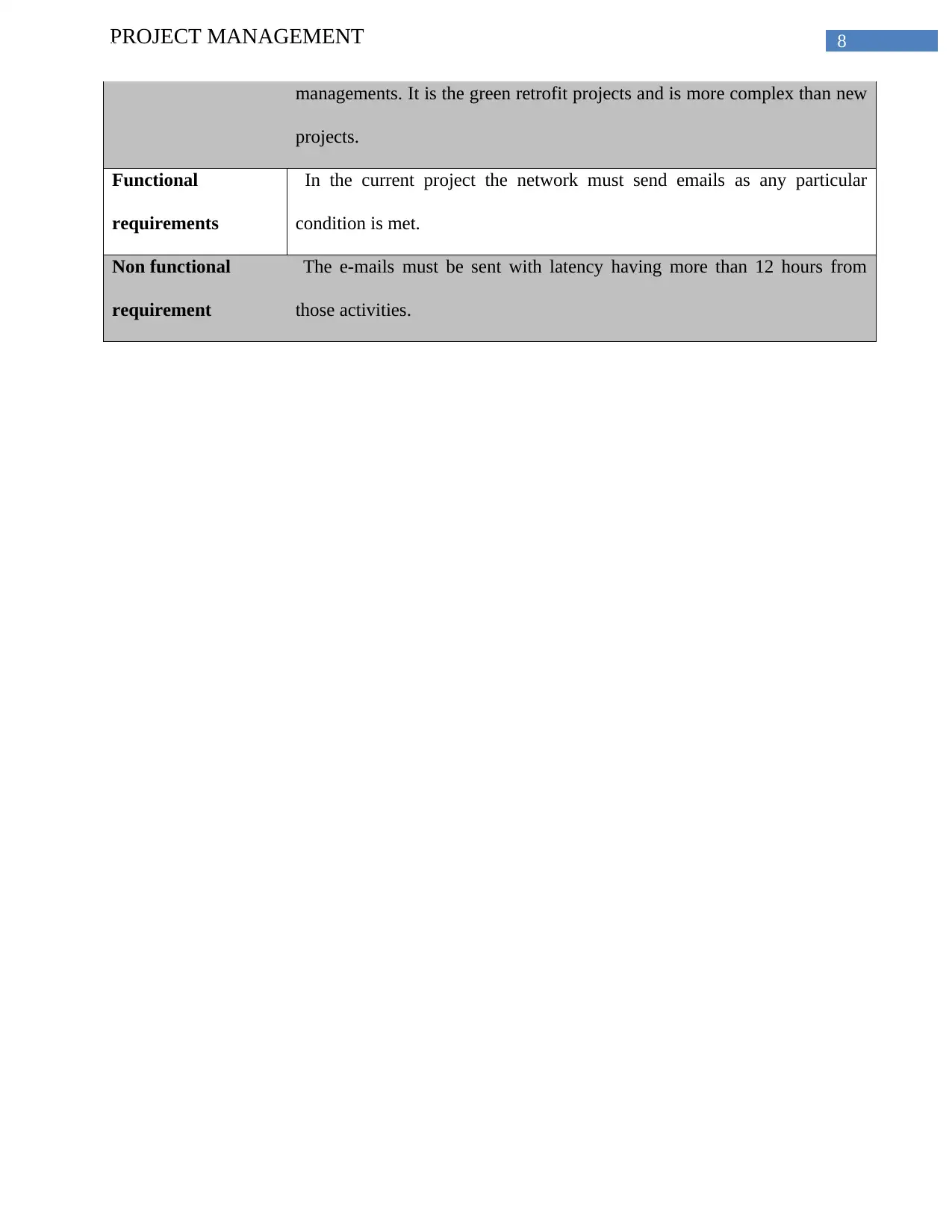
8PROJECT MANAGEMENT
managements. It is the green retrofit projects and is more complex than new
projects.
Functional
requirements
In the current project the network must send emails as any particular
condition is met.
Non functional
requirement
The e-mails must be sent with latency having more than 12 hours from
those activities.
managements. It is the green retrofit projects and is more complex than new
projects.
Functional
requirements
In the current project the network must send emails as any particular
condition is met.
Non functional
requirement
The e-mails must be sent with latency having more than 12 hours from
those activities.
⊘ This is a preview!⊘
Do you want full access?
Subscribe today to unlock all pages.

Trusted by 1+ million students worldwide
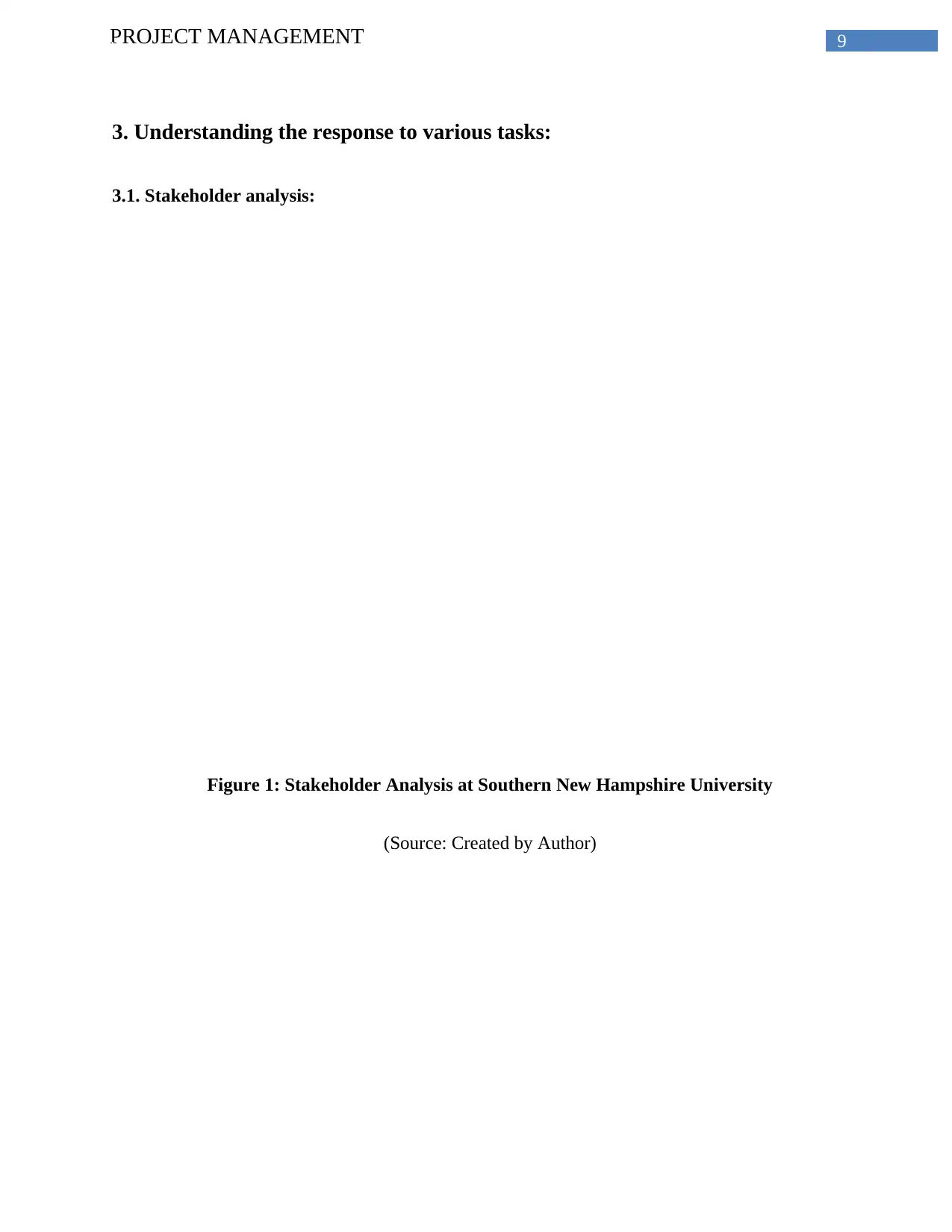
9PROJECT MANAGEMENT
3. Understanding the response to various tasks:
3.1. Stakeholder analysis:
Figure 1: Stakeholder Analysis at Southern New Hampshire University
(Source: Created by Author)
3. Understanding the response to various tasks:
3.1. Stakeholder analysis:
Figure 1: Stakeholder Analysis at Southern New Hampshire University
(Source: Created by Author)
Paraphrase This Document
Need a fresh take? Get an instant paraphrase of this document with our AI Paraphraser
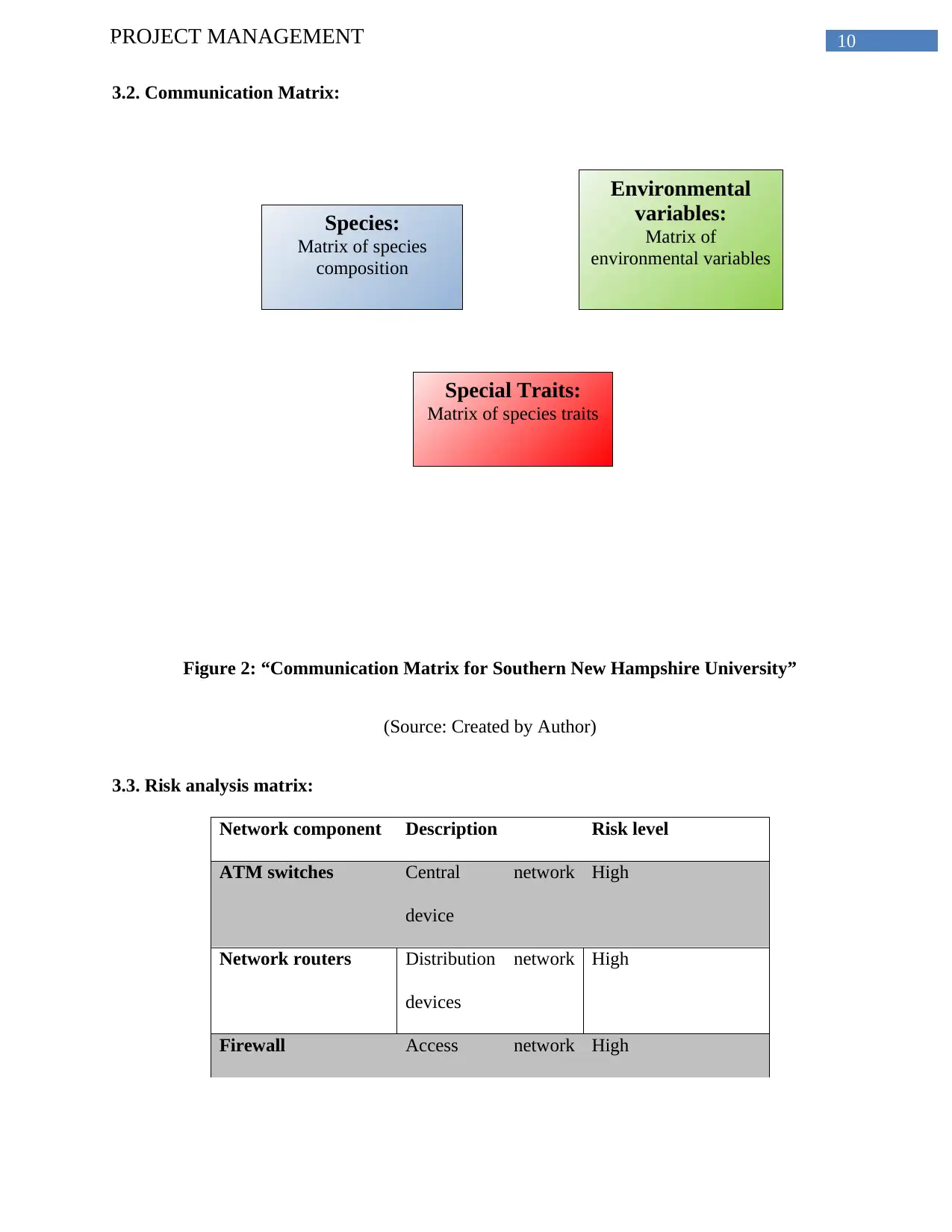
10PROJECT MANAGEMENT
Species:
Matrix of species
composition
Environmental
variables:
Matrix of
environmental variables
Special Traits:
Matrix of species traits
3.2. Communication Matrix:
Figure 2: “Communication Matrix for Southern New Hampshire University”
(Source: Created by Author)
3.3. Risk analysis matrix:
Network component Description Risk level
ATM switches Central network
device
High
Network routers Distribution network
devices
High
Firewall Access network High
Species:
Matrix of species
composition
Environmental
variables:
Matrix of
environmental variables
Special Traits:
Matrix of species traits
3.2. Communication Matrix:
Figure 2: “Communication Matrix for Southern New Hampshire University”
(Source: Created by Author)
3.3. Risk analysis matrix:
Network component Description Risk level
ATM switches Central network
device
High
Network routers Distribution network
devices
High
Firewall Access network High
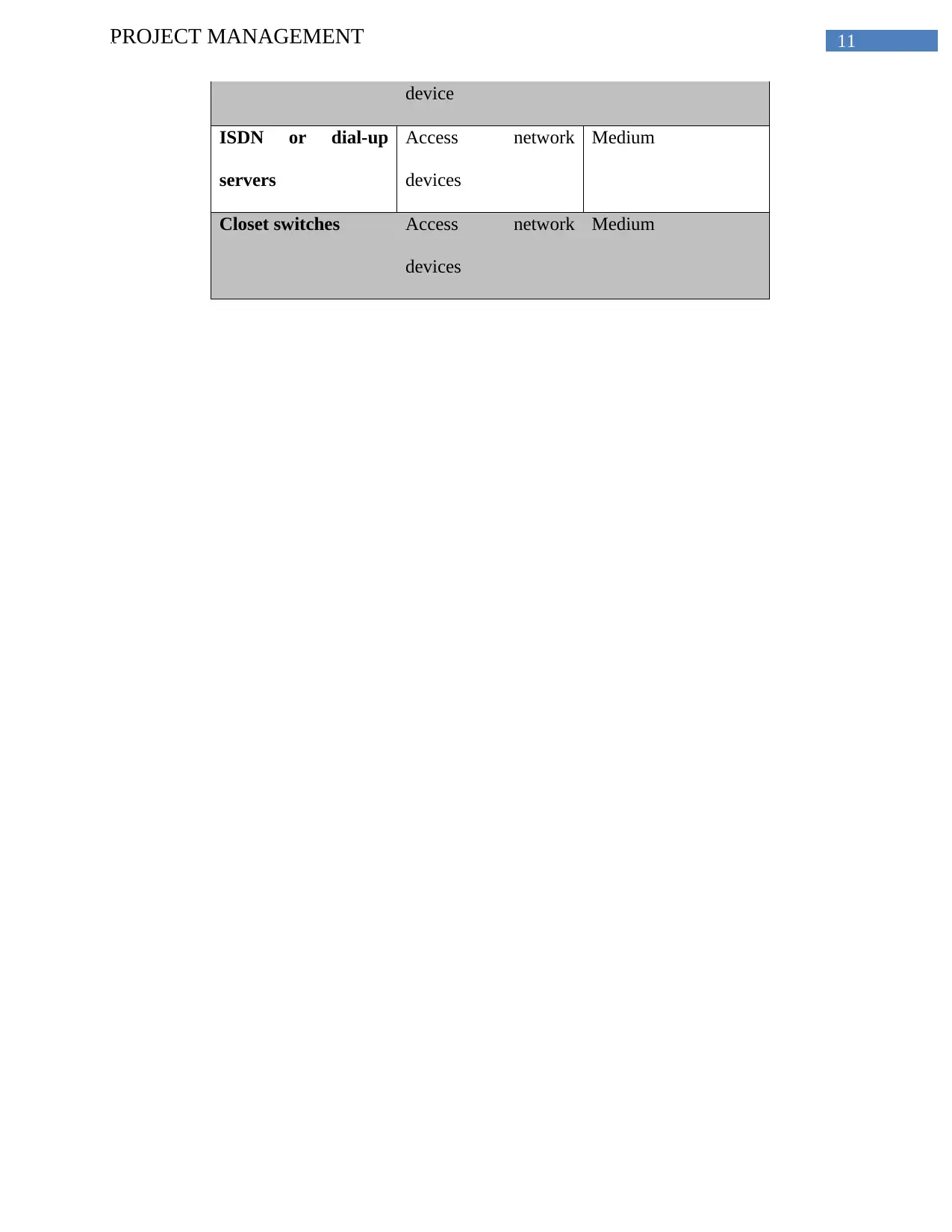
11PROJECT MANAGEMENT
device
ISDN or dial-up
servers
Access network
devices
Medium
Closet switches Access network
devices
Medium
device
ISDN or dial-up
servers
Access network
devices
Medium
Closet switches Access network
devices
Medium
⊘ This is a preview!⊘
Do you want full access?
Subscribe today to unlock all pages.

Trusted by 1+ million students worldwide
1 out of 20
Related Documents
Your All-in-One AI-Powered Toolkit for Academic Success.
+13062052269
info@desklib.com
Available 24*7 on WhatsApp / Email
![[object Object]](/_next/static/media/star-bottom.7253800d.svg)
Unlock your academic potential
Copyright © 2020–2025 A2Z Services. All Rights Reserved. Developed and managed by ZUCOL.


